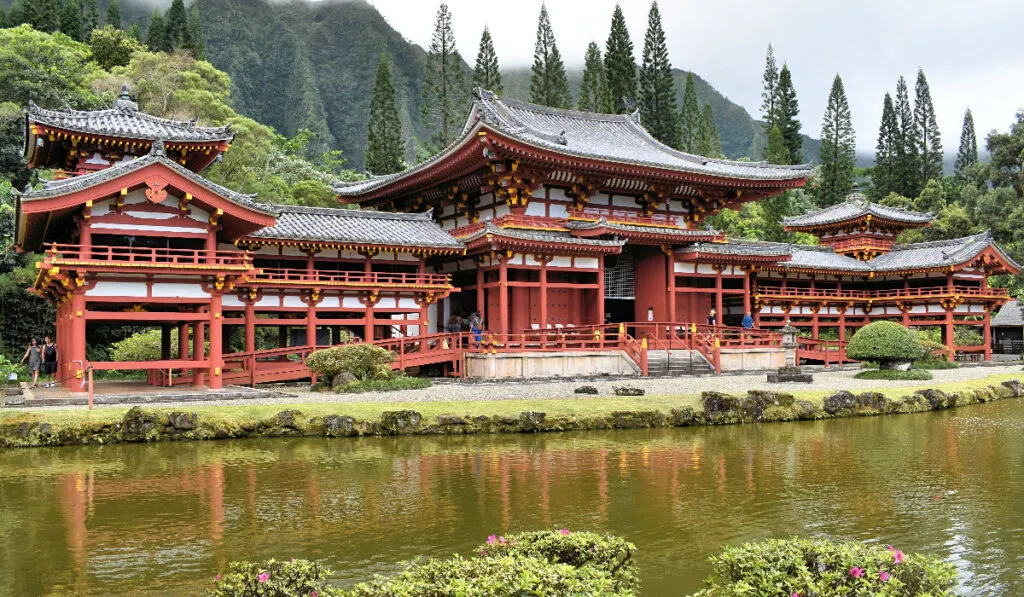
The Byodo-In Temple at the Valley of the Temples was one of the highlights of my last vacation to Hawaii. Located at the foot of the beautiful Ko’olau Mountains on Kahekili Highway in Kaneohe, it’s a relaxing 30-minute drive from Waikiki.
With an entrance fee of just USD 5 (by debit or credit only), it’s an inexpensive and unique activity suited to families. While many might be familiar with the Byodo-In Buddhist Temple in Japan, Oahu’s version is a half-scale replica.
Although I had visited Oahu before, I could not find the beautiful red temple by address alone. From the highway, I could not see the temple. However, on my last visit, I found it by my car’s GPS.
But nestled in the back of the Valley of the Temples Memorial Park, it’s a treasure worth waiting to see. So, I highly recommend you visit Byodo-In Temple, Oahu’s Buddhist Temple.
Directions To The Temple
The directions to the temple is easy if you know where you’re going. From Honolulu, travel on the H1 East and take the exit 20A toward Kaneohe/Honolulu.
Planning your trip to Oahu?
- 🏠 Find your perfect accommodation on Booking.com
- 🎡 Make your trip more excited with Viator
- 🚘 Hire a car on Rentalcars.com
Merge onto the Likelike Highway or HI-63 N, then take the exit to Kahekili Hwy and turn right. Continue on the highway to HI-83 W.
Make a left at Haiku Road, and then a right on Kamehameha Hwy. Turn left into the Valley of the Temples Memorial Park.
I visited the Byodo-In Temple on my way to a Luau at the Polynesian Cultural Center. I did not expect to find the Japanese temple in a cemetery.
As I entered the Valley of Temples Memorial Park, the attendant in the little hut directed me to the narrow winding road that leads to the back of the cemetery and the much-anticipated Temple.
I still remember driving through the Kaneohe Memorial Cemetery and catching my first glimpse of the Hawaiian temple through the trees. Its stunning vista at the foot of the lush green mountains took my breath away, and I was instantly transported to Japan.
Excited, I couldn’t wait to park the car and explore this little treasure.
General Admissions
The Temple is open between 8:30 am and 4:30 pm daily, with the last entrance at 4:15 pm. Admission fee a bargain at USD 5 per adult, USD 3 for seniors, and USD 2 for children, making it an awesome almost free Oahu activity.
Even though the general admission was nominal, I had already purchased Go Oahu passes which included admission.
Walking across the wooden footbridge and approaching the shrine, I felt a sense of peacefulness and harmony. A large reflecting pond surrounds the holy structure and meanders around the beautiful temple grounds.
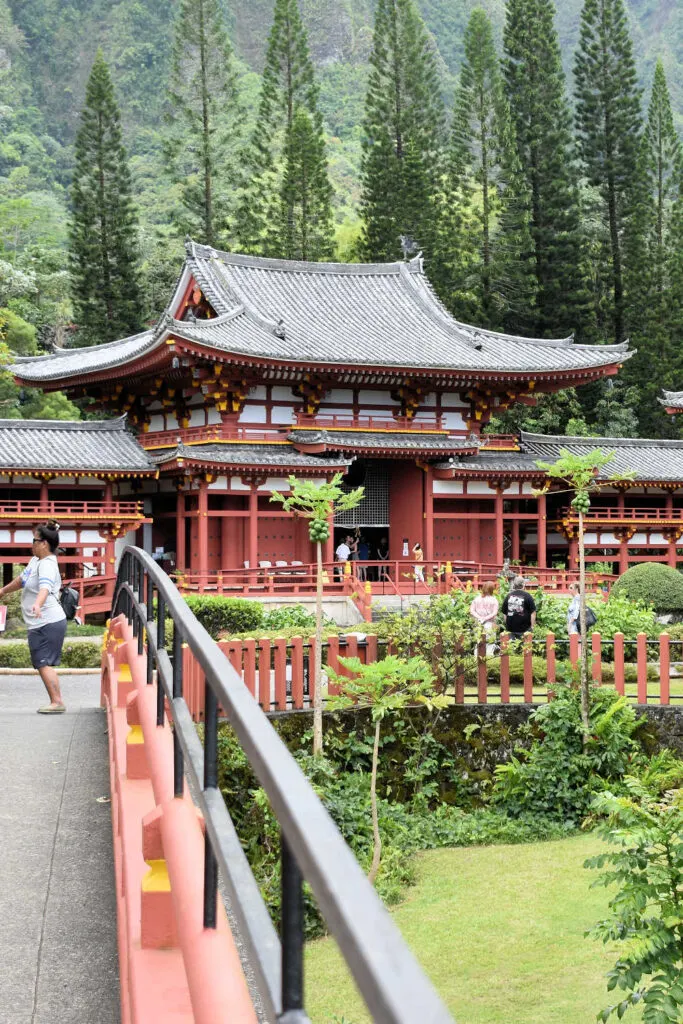
If you’re looking to escape the crowds in Waikiki and want a little serenity, Oahu’s Buddhist Temple is worthy of a visit. Here are the top 5 highlights of visiting this hidden gem.
Byodo-In Temple’s History
The Byodo-In Temple in Oahu is a half-scale replica of the Buddhist temple Japan. This temple was commissioned in 1968 to celebrate the 100th anniversary of the first Japanese immigrants to Hawaii. It replicates the 11th-century Phoenix Hall in Uji, Japan.
While the original was built of wood, this modern-day version is constructed mostly of concrete. However, this temple is a stunning piece of architecture, so be sure to check out the intricate roof, rafters, and small details found everywhere.
The temple serves as a non-practicing Buddhist temple and a place of peace. It aims to foster cultural ties between Japan and Hawaii, and welcomes people of all faiths.
Also, there is a replica of the famous bon-sho bell to the left of the temple, near the entrance.
Throughout the years, the picturesque temple has been featured in films and shows, such as Magnum, P.I, Lost, Pearl Harbor, and Hawaii Five-O.
You can visit this temple and feel like you’re in Japan.
The Sacred Bell

When you arrive at the temple, take the left path along the pond to the temple. First, you’ll encounter a wooden structure containing the bon-sho or “sacred bell.”
This sacred bell was cast in Osaka, Japan, with the assistance of the Japanese government. This large three-ton bell measures five feet high and almost four feet wide.
Like its counterpart at the Uji Byodo-In, it is housed in a bell house or kanetru-ki-do. Renowned for its shape, sound, and calligraphy, the large bell is separated into four sections depicting the Buddhist concept of heaven.
Visitors arriving at the temple, take pleasure in ringing the bell using the soft wooden log called a shumoku. The unique tones of the bon-sho help to clear the mind of negativity, impart deep peace, and bring happiness, blessings, and long life.
It’s advised to ring the bell to purify your mind before entering the temple. With this in mind, my husband and I took turns ringing the bell and listening to its calming tone.
As I continued along the path towards the temple, a short trail leads off to the left and up to the meditation pavilion. Located next to a narrow section of the pond, the Tusri-Dono, as it was initially called, translates to Emperor’s fishing pavilion.

Nestled amongst the trees and beautiful gardens, it’s the perfect place for meditation and being one with nature.
Heading down from the meditation pavilion, I got a first glimpse of the sizable koi in the pond below. huddled near some small waterfalls, their size size shocked me. While the koi gather, waiting to be fed, do not feed them human food.
The small gift shop on the other side of the temple sells small bags of fish food to feed the hungry fish.
The Byodo-In Temple
While Oahu’s Byodo-In Temple is not a practicing temple, it’s still important to be respectful and quiet at all times. Before entering the Hawaiian temple, you have to remove your shoes at the door.
Inside, the architecture and an impressive nine-foot golden statue of the Amida Buddha sitting on a gold leaf amazed me. Sculpted by Masuzo Inui, according to the temple staff, it is the largest Buddha outside of Japan.
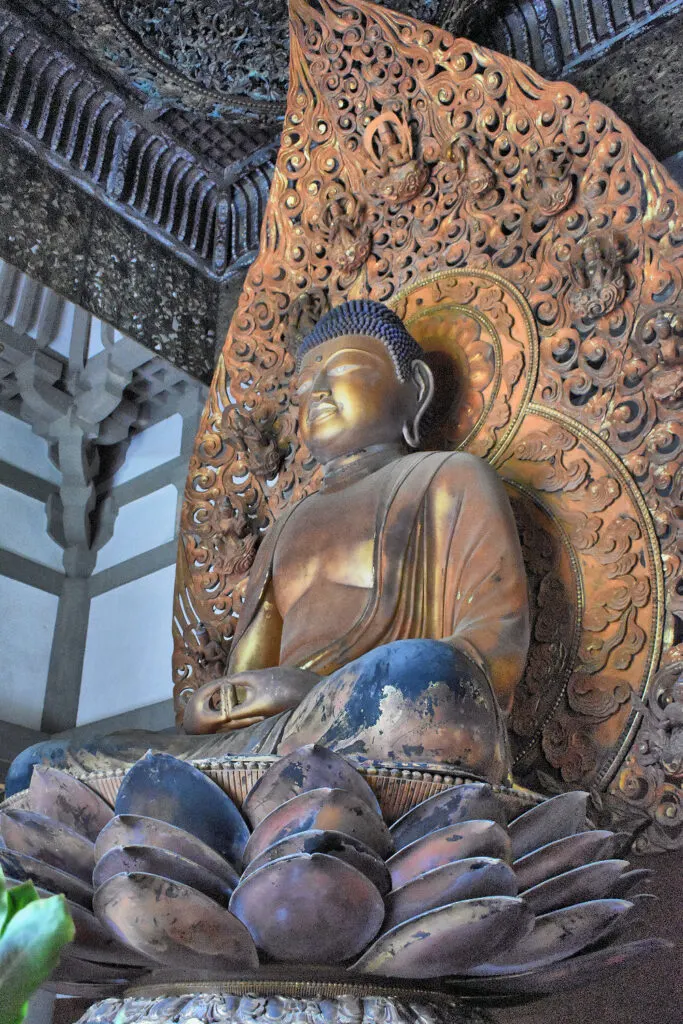
After carving, it got a gold lacquer and leaf finish. It’s surrounded by 52 smaller sculptures of enlightened beings. These artworks capture the Fujiwara aristocracy’s culture.
People call the main hall the Phoenix Hall or Hoo-do, and it’s flanked by two wings providing stability and beauty symmetry. On the roof, two phoenixes symbolize good fortune and Chinese influence.
I lit some incense in front of the Buddha and took some time to really appreciate this special place. From the front of the temple entrance, I admired the manicured zen rock gardens. Apparently, practicing raking of a “dry garden” teaches priests the art of concentration.
Being part of the cemetery, the temple holds memorial and funeral services. The non-practicing temple also hosts other momentous events, such as engagements, wedding ceremonies and vow renewals.
The Reflecting Pond
As I left the temple and walked across the lovely bridge to the gift shop, the hundreds of large koi in the reflecting pond startled me. It was obvious these fish knew exactly where visitors would feed them.
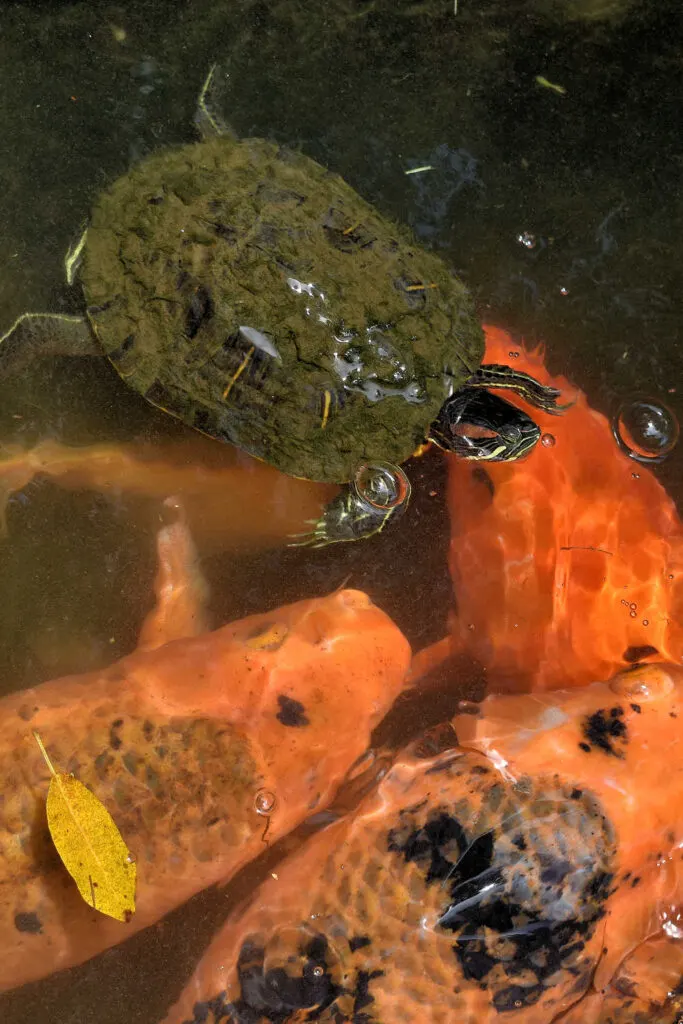
Be sure to purchase a bag or two of pellets and watch the frenzy of fish flipping around in the water trying to get their fair share. While we bought three tiny bags; the birds, black swans, koi, and even a turtle devoured the pellets quickly.
I felt sorry for the small turtle who was getting bashed around as the koi thrashed in the still waters.
Seeing these koi brought back memories of when I had my own koi pond a few years ago. However, the Asian temple’s pond held the largest number of koi I had ever seen in my life.
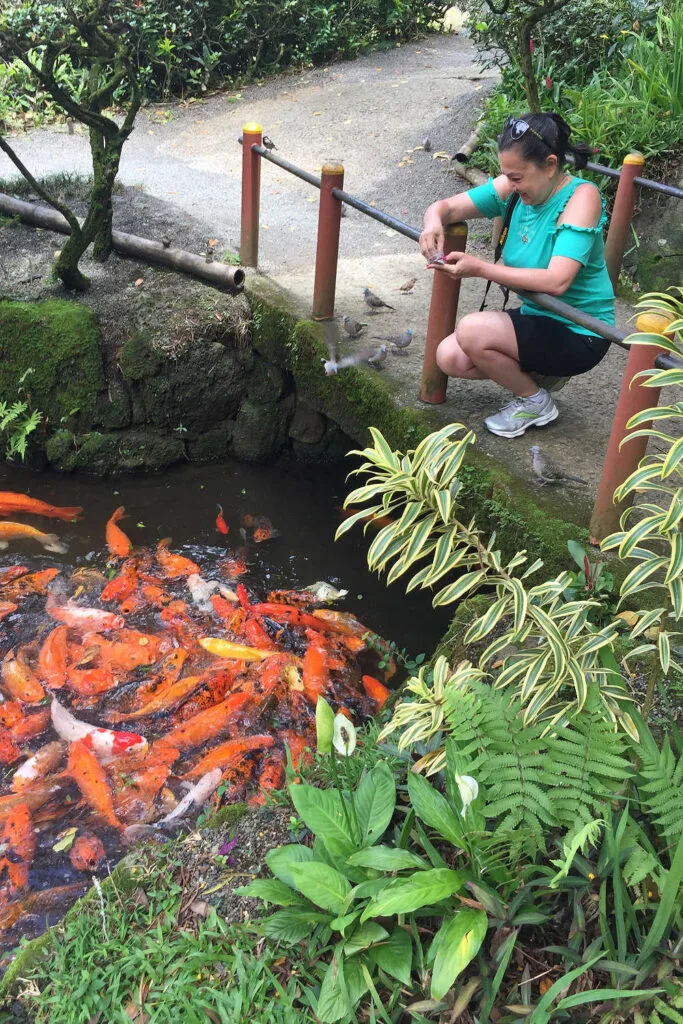
The Wildlife
Black swans, small turtles, frogs, and peacocks are commonly spotted at the temple. However, the highlight for many are the abundance of koi also known as carp which co-exist in the waters. The wild peacocks come and go so you may not always see them.
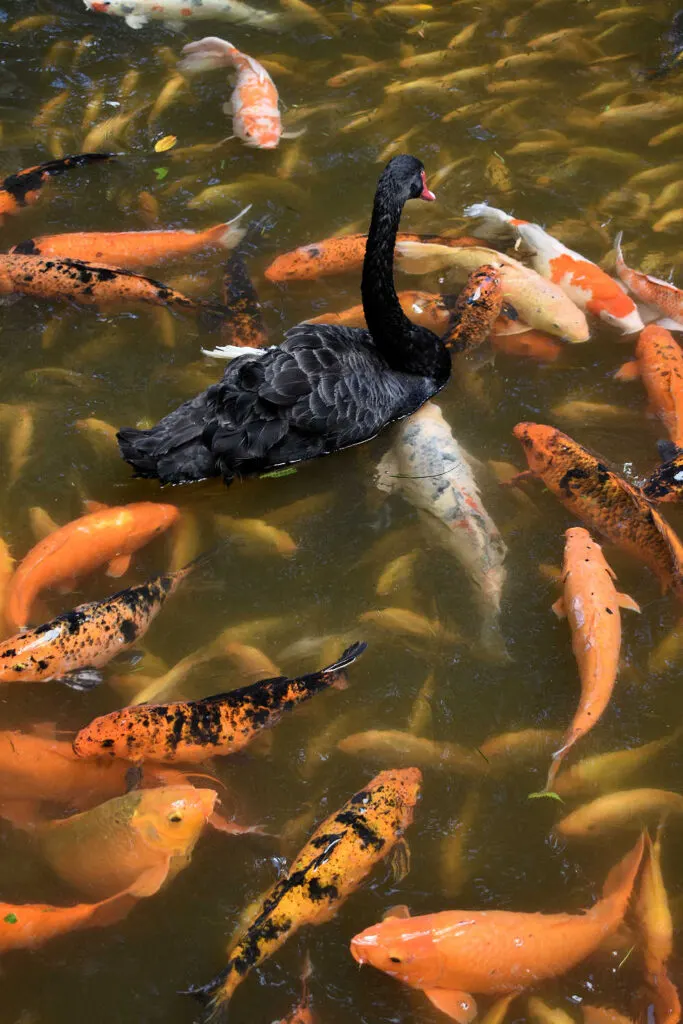
Koi are often hard to care for, especially outside of their natural home. I’ve had koi ponds, so I know. In other areas of the world, raccoons and herons will feast on koi if the ponds are left unprotected.
With no natural predictors in Hawaii, these fish can grown quite large. If you’re traveling to Oahu with kids, feeding these koi might be the highlight of their vacation.

Conclusion
There are over 70 beautiful Buddhist temples on Oahu; however, the Byodo-In Temple might be the most visited and picturesque one. If you’e driving from Waikiki, it doesn’t take long to visit the Byodo-In Temple.
So, why not combine your day with a Kualoa Ranch excursion. The active cattle ranch is a great place to enjoy adventurous excursions such as zip lining, e-biking, ATVing, and their popular Jurassic Adventure Tour.
Is the Oahu Buddhist temple the island’s best-kept secret? Visit there and judge for yourself. For me, the temple is a Hawaiian treasure that I will surely see again.
My husband and I visited this Oahu temple as part of our Hawaiian honeymoon cruise. After three visits to the Hawaiian Islands, I was thrilled I finally found this hidden treasure and will definitely be stopping by again in the near future.
Whether you have a week or just a few days in Oahu, you should consider adding the temple to your Hawaiian itinerary. The best time for visitation is early morning when the sun lights up the temple.


